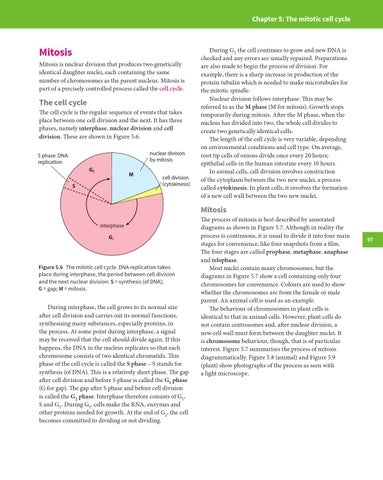Chapter 5: The mitotic cell cycle
Mitosis Mitosis is nuclear division that produces two genetically identical daughter nuclei, each containing the same number of chromosomes as the parent nucleus. Mitosis is part of a precisely controlled process called the cell cycle.
The cell cycle
The cell cycle is the regular sequence of events that takes place between one cell division and the next. It has three phases, namely interphase, nuclear division and cell division. These are shown in Figure 5.6. nuclear division by mitosis
S phase: DNA replication G2
M
S
cell division (cytokinesis)
During G2 the cell continues to grow and new DNA is checked and any errors are usually repaired. Preparations are also made to begin the process of division. For example, there is a sharp increase in production of the protein tubulin which is needed to make microtubules for the mitotic spindle. Nuclear division follows interphase. This may be referred to as the M phase (M for mitosis). Growth stops temporarily during mitosis. After the M phase, when the nucleus has divided into two, the whole cell divides to create two genetically identical cells. The length of the cell cycle is very variable, depending on environmental conditions and cell type. On average, root tip cells of onions divide once every 20 hours; epithelial cells in the human intestine every 10 hours. In animal cells, cell division involves constriction of the cytoplasm between the two new nuclei, a process called cytokinesis. In plant cells, it involves the formation of a new cell wall between the two new nuclei.
Mitosis interphase G1
Figure 5.6 The mitotic cell cycle. DNA replication takes place during interphase, the period between cell division and the next nuclear division: S = synthesis (of DNA); G = gap; M = mitosis.
During interphase, the cell grows to its normal size after cell division and carries out its normal functions, synthesising many substances, especially proteins, in the process. At some point during interphase, a signal may be received that the cell should divide again. If this happens, the DNA in the nucleus replicates so that each chromosome consists of two identical chromatids. This phase of the cell cycle is called the S phase – S stands for synthesis (of DNA). This is a relatively short phase. The gap after cell division and before S phase is called the G1 phase (G for gap). The gap after S phase and before cell division is called the G2 phase. Interphase therefore consists of G1, S and G2. During G1, cells make the RNA, enzymes and other proteins needed for growth. At the end of G1, the cell becomes committed to dividing or not dividing.
The process of mitosis is best described by annotated diagrams as shown in Figure 5.7. Although in reality the process is continuous, it is usual to divide it into four main stages for convenience, like four snapshots from a film. The four stages are called prophase, metaphase, anaphase and telophase. Most nuclei contain many chromosomes, but the diagrams in Figure 5.7 show a cell containing only four chromosomes for convenience. Colours are used to show whether the chromosomes are from the female or male parent. An animal cell is used as an example. The behaviour of chromosomes in plant cells is identical to that in animal cells. However, plant cells do not contain centrosomes and, after nuclear division, a new cell wall must form between the daughter nuclei. It is chromosome behaviour, though, that is of particular interest. Figure 5.7 summarises the process of mitosis diagrammatically. Figure 5.8 (animal) and Figure 5.9 (plant) show photographs of the process as seen with a light microscope.
97
